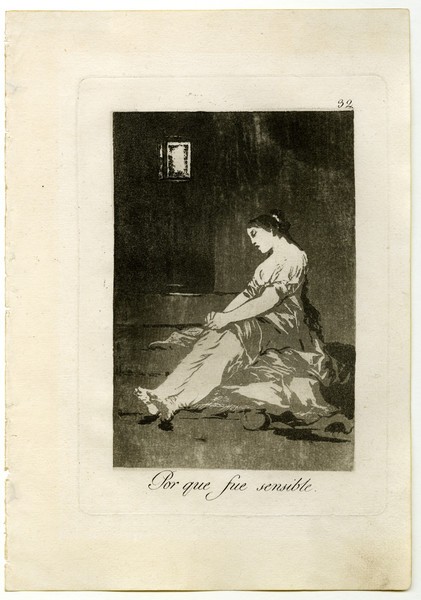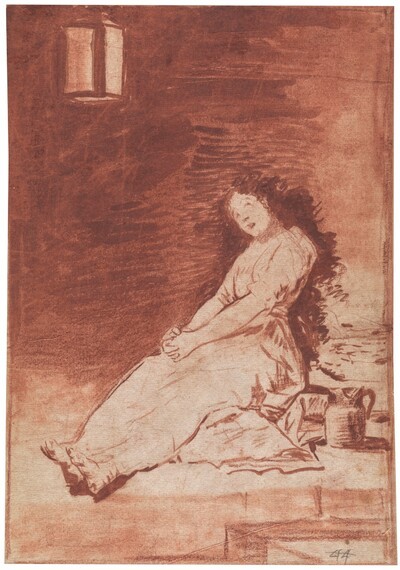- Cronología
- Ca. 1797 - 1799
- Dimensiones
- 219 x 153 mm
- Técnica y soporte
- Aguatinta y punta seca
- Reconocimiento de la autoría de Goya
- Undisputed work
- Ficha: realización/revisión
- 13 Aug 2013 / 29 May 2024
- Inventario
- 225
Por que fue sensible. (at the bottom)
32.(in the upper right-hand corner)
See Francisco de Goya y Lucientes, Painter.
A proof before the letter, preserved in the Bibliothèque Nationale de France in Paris, reveals a different manuscript title, the Soleda, without the final "d". Two other proofs exist, one of them with the definitive title also in manuscript.
A preparatory drawing for this engraving has been preserved.
In a prison cell, a young woman is shown seated on the rungs of a ladder with her hands clasped on her knees. Next to her are an earthenware vessel and the silhouette of a rat, alluding to the gloomy atmosphere and conditions in prisons at the time. The scene is illuminated by a lantern hanging overhead, slightly offset to the left.
In this print Goya demonstrates his mastery of the aquatint technique, as he uses it for the whole of the engraving, without the support of the lines of the etching. He used two types of aquatint over light strokes of drypoint. He also used some varnish reserves to achieve vibrant whites on the face and the continuous line of the woman's body.
It is likely that this engraving is a continuation of the previous one, no. 31, Pray for her. The celestina's prayers have not been heard and the prostitute who accompanied her has been imprisoned. This can be deduced from what the manuscript in the Prado Museum notes about this engraving: "As it must be! This world has its ups and downs. The life she brought with her could not stop at anything else". Furthermore, understanding of this image would be completed by the information provided by the Ayala manuscript, which indicates that it is Castillo's wife and that the young woman may have been pregnant.
Francisco del Castillo's wife was María Vicenta Mendieta, aged 32, who helped her lover, a younger cousin, Santiago San Juan, to kill her husband. Goya must have been close to the trial, held in February 1798, as his friend Juan Meléndez Valdés (Ribera del Fresno, Badajoz, 1754-Montpellier, 1817) was appointed prosecutor in the case precisely during the period when Jovellanos was Minister of Grace and Justice. María Vicenta Mendieta and her lover were executed on 23 April 1798 in the Madrid Main Square, as reported in El diario de Madrid. This event was dealt with by Goya in his works The Visit of a Friar and Interior of a Prison, in which he was more eloquent and focused not so much on the murder as on the death sentence handed down to the woman.
The plate is preserved in the National Chalcography (no. 203).
-
Goya. Gemälde Zeichnungen. Graphik. TapisserienKunsthalle BaselBasle1953from January 23th to April 12th 1953cat. 222
-
Goya. Das Zeitalter der Revolucionen. Kunst um 1800 (1980 – 1981)Hamburger KunsthalleHamburg1980cat. 31
-
Goya. La década de Los CaprichosMadrid1992organized by Real Academia de Bellas Artes de San Fernando sponsored by Fundación Central Hispano, Madrid, consultant editor Nigel Glendinnig. From October 26th 1992 to January 10th 1993cat. 102
-
Francisco de GoyaMuseo d'Arte ModernaLugano1996exhibition celebrated from September 22nd to November 17th.cat. 32, p.59
-
Ydioma universal: Goya en la Biblioteca NacionalBiblioteca NacionalMadrid1996from September 19th to December 15th 1996cat. 131
-
Francisco Goya. Sein leben im spiegel der graphik. Fuendetodos 1746-1828 Bordeaux. 1746-1996Galerie KornfeldBern1996from November 21st 1996 to January 1997cat. 38
-
Goya. La imagen de la mujerMuseo Nacional del PradoMadrid2001from October 30th 2001 to February 10th 2002. Exhibitied also at the National Gallery of Art, Washington, March 10th to June 2nd 2002, consultant editor Francisco Calvo Serrallercat. 95
-
Goya e la tradizione italianaFondazione Magnani RoccaMamiano di Traversetolo (Parma)2006consultant editors Fred Licht and Simona Tosini Pizzetti. From September 9th to December 3th 2006cat. 32, p.153
-
Goya. Opera graficaPinacoteca del Castello di San GiorgioLegnano2006exhibition celebrated from December 16th 2006 to April 1st 2007p.31
-
Goya et la modernitéPinacothèque de ParisParís2013from October 11st 2013 to March 16th 2014cat. 192
-
Goya: Order and disorderMuseum of Fine ArtsBoston2014cat. 204
-
Madrid2017
-
2022
-
Goya engravings and lithographs, vol. I y II.OxfordBruno Cassirer1964p.103, cat. 67
-
Vie et ouvre de Francisco de GoyaParísOffice du livre1970p.180, cat. 515
-
GoyaParísMinistère d’Etat-Affaires culturelles y Réunion des Musées Nationaux1970p.396, cat. 643
-
Porque fue sensibleHistoria 16Madrid1978pp.91-96
-
Goya and Women in the Caprichos. The case os Castillo's wifeApolloLondon1978pp.130-134
-
Goya, la década de los caprichos: dibujos y aguafuertesMadridReal Academia de Bellas Artes de San Fernando1992pp.173-176, cat. 101-103
-
Goya. El capricho y la invención. Cuadros de gabinete, bocetos y miniaturasMadridMuseo del Prado1993pp.272-273, fig. 186
-
Catálogo de las estampas de Goya en la Biblioteca NacionalMadridMinisterio de Educación y Cultura, Biblioteca Nacional1996p.91, cat. 121
-
El libro de los caprichos: dos siglos de interpretaciones (1799-1999). Catálogo de los dibujos, pruebas de estado, láminas de cobre y estampas de la primera ediciónMadridMuseo Nacional del Prado1999pp.192-195
-
ParísPinacoteca de París2013p. 258
-
Goya: Order & DisorderBostonMuseum of Fine Arts Boston Publications2014p. 299
-
Goya. In the Norton Simon MuseumPasadenaNorton Simon Museum2016pp. 42-75
-
ZaragozaGobierno de Aragón y Fundación Bancaria Ibercaja2017p. 259
-
Museo de Bellas Artes de Badajoz y Diputación de Badajoz2022p. 41

